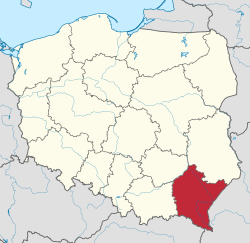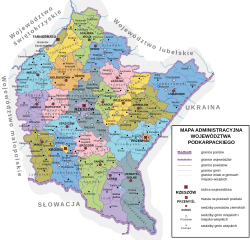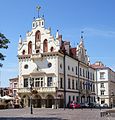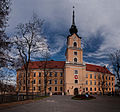Subcarpathian Voivodeship
Subcarpathian Voivodeship is a voivodeship, or province, in the southeastern corner of Poland. Its administrative capital and largest city is Rzeszów. Along with the Marshal, it is governed by the Subcarpathian Regional Assembly.
The name derives from the region's location near the Carpathian Mountains, and the voivodeship comprises areas of two historic regions of Central Europe—Lesser Poland (western and northwestern counties) and Cherven Cities/Red Ruthenia.
It is bordered by Lesser Poland Voivodeship to the west, Świętokrzyskie Voivodeship to the north-west, Lublin Voivodeship to the north, Ukraine (Lviv Oblast and Zakarpattia Oblast) to the east and Slovakia (Prešov Region) to the south. It covers an area of 17,844 square kilometres (6,890 sq mi), and has a population of 2,127,462 (as at 2019). The voivodeship is mostly hilly or mountainous (see Bieszczady, Beskidy); its northwestern corner is flat. It is one of the most wooded Polish voivodeships (35.9% of total area), within its borders there is whole Bieszczady National Park, and parts of Magura National Park.
History
[edit]

In the Early Middle Ages, the territory was inhabited by the Vistulans and Lendians, old Polish tribes. It formed part of Poland since its first historic ruler Mieszko I, however, later on, at various times, portions of the region fell under the Kievan Rus', the Golden Horde, and the Kingdom of Hungary, before Poland regained full control in the 14th century. Following the Partitions of Poland the entire region was annexed by Austria and included within the newly established Kingdom of Galicia and Lodomeria. The oldest cities in the province, with over 1,000 years of history, are Przemyśl and Sanok. Rzeszów, Łańcut and Tarnobrzeg, with their castles and palaces, were important residential cities of the powerful Polish magnate families of Lubomirski, Potocki and Tarnowski.
During the interwar period (1918–1939), territory of the Subcarpathian Voivodeship was part of the Lwów Voivodeship and belonged to "Poland B", the less-developed, more rural parts of Poland. To boost the local economy, the government of the Second Polish Republic began in the mid-1930s a massive program of industrialization, known as the Central Industrial Region. The program created several major armament factories, including PZL Mielec, PZL Rzeszów, Huta Stalowa Wola, and factories in other Subcarpathian towns such as Dębica, Nowa Dęba, Sanok, Tarnobrzeg and Nowa Sarzyna.
Following the joint German-Soviet invasion of Poland, which started World War II in September 1939, most of the current province was occupied by Nazi Germany with the eastern outskirts occupied by the Soviet Union, and the city of Przemyśl divided between the occupiers until 1941, and then the entire region occupied by Germany until 1944.
Following the Soviet annexation of the regional capital of Lwów, Rzeszów was chosen as the new regional capital and the Rzeszów Voivodeship was founded.
The voivodeship was created on 1 January 1999 out of the former Rzeszów, Przemyśl, Krosno and (partially) Tarnów and Tarnobrzeg Voivodeships, pursuant to the Polish local-government reforms adopted in 1998.
Government
[edit]Subcarpathian Voivodeship's government powers are shared between the voivode (governor), the sejmik (regional assembly), and the marshal.
Cities and towns
[edit]





The voivodeship contains 6 cities and 45 towns. These are listed below in descending order of population (according to official figures as of 2019)[4]
- Rzeszów (194,886)
- Przemyśl (60,999)
- Stalowa Wola (60,799)
- Mielec (60,366)
- Tarnobrzeg (46,907)
- Krosno (46,369)
Towns:
- Dębica (45,634)
- Jarosław (37,585)
- Sanok (37,381)
- Jasło (35,063)
- Łańcut (17,709)
- Ropczyce (15,836)
- Przeworsk (15,356)
- Nisko (15,324)
- Leżajsk (13,853)
- Sędziszów Małopolski (12,357)
- Lubaczów (12,018)
- Nowa Dęba (11,152)
- Ustrzyki Dolne (9,097)
- Kolbuszowa (9,075)
- Strzyżów (8,884)
- Brzozów (7,463)
- Rudnik nad Sanem (6,710)
- Głogów Małopolski (6,654)
- Boguchwała (6,179)
- Dynów (6,129)
- Nowa Sarzyna (5,834)
- Jedlicze (5,736)
- Lesko (5,424)
- Radymno (5,279)
- Zagórz (5,095)
- Pilzno (4,912)
- Sokołów Małopolski (4,193)
- Rymanów (3,825)
- Tyczyn (3,824)
- Pruchnik (3,764)
- Radomyśl Wielki (3,231)
- Kańczuga (3,167)
- Zaklików (2,979)
- Oleszyce (2,974)
- Brzostek (2,752)
- Sieniawa (2,140)
- Błażowa (2,139)
- Narol (2,109)
- Dukla (2,061)
- Cieszanów (1,913)
- Iwonicz-Zdrój (1,787)
- Przecław (1,775)
- Baranów Sandomierski (1,456)
- Ulanów (1,422)
- Kołaczyce (1,409)
- Jawornik Polski
- Bircza
- Dubiecko (866)
Administrative division
[edit]Subcarpathian Voivodeship is divided into 25 counties (powiats): 4 city counties and 21 land counties. These are further divided into 160 gminas.
The counties are listed in the following table (ordering within categories is by decreasing population).
| English and Polish names |
Area | Population (2019) |
Seat | Other towns | Total gminas | |
| km2 | sq mi | |||||
| City counties | ||||||
| Rzeszów | 77 | 30 | 194,886 | 1 | ||
| Przemyśl | 44 | 17 | 60,999 | 1 | ||
| Tarnobrzeg | 86 | 33 | 46,907 | 1 | ||
| Krosno | 43 | 17 | 46,369 | 1 | ||
| Land counties | ||||||
| Rzeszów County powiat rzeszowski |
471 | 182 | 168,614 | Rzeszów * | Boguchwała, Głogów Małopolski, Sokołów Małopolski, Błażowa, Tyczyn | 14 |
| Mielec County powiat mielecki |
880 | 340 | 136,591 | Mielec | Radomyśl Wielki, Przecław | 10 |
| Dębica County powiat dębicki |
776 | 300 | 135,348 | Dębica | Pilzno, Brzostek | 7 |
| Jarosław County powiat jarosławski |
1,029 | 397 | 120,462 | Jarosław | Radymno, Pruchnik | 11 |
| Jasło County powiat jasielski |
830 | 320 | 113,730 | Jasło | Kołaczyce | 10 |
| Krosno County powiat krośnieński |
924 | 357 | 112,301 | Krosno * | Jedlicze, Rymanów, Dukla, Iwonicz-Zdrój | 10 |
| Stalowa Wola County powiat stalowowolski |
833 | 322 | 106,272 | Stalowa Wola | Zaklików | 6 |
| Sanok County powiat sanocki |
1,225 | 473 | 94,473 | Sanok | Zagórz | 8 |
| Łańcut County powiat łańcucki |
452 | 175 | 80,898 | Łańcut | 7 | |
| Przeworsk County powiat przeworski |
698 | 269 | 78,354 | Przeworsk | Kańczuga, Sieniawa, Jawornik Polski | 9 |
| Ropczyce-Sędziszów County powiat ropczycko-sędziszowski |
549 | 212 | 74,416 | Ropczyce | Sędziszów Małopolski | 5 |
| Przemyśl County powiat przemyski |
1,214 | 469 | 74,234 | Przemyśl * | Dubiecko, Bircza | 10 |
| Leżajsk County powiat leżajski |
583 | 225 | 69,479 | Leżajsk | Nowa Sarzyna | 5 |
| Nisko County powiat niżański |
786 | 303 | 66,699 | Nisko | Rudnik nad Sanem, Ulanów | 7 |
| Brzozów County powiat brzozowski |
540 | 210 | 65,652 | Brzozów | 6 | |
| Kolbuszowa County powiat kolbuszowski |
774 | 299 | 62,389 | Kolbuszowa | 6 | |
| Strzyżów County powiat strzyżowski |
503 | 194 | 61,505 | Strzyżów | 5 | |
| Lubaczów County powiat lubaczowski |
1,308 | 505 | 55,438 | Lubaczów | Oleszyce, Narol, Cieszanów | 8 |
| Tarnobrzeg County powiat tarnobrzeski |
520 | 200 | 53,115 | Tarnobrzeg * | Nowa Dęba, Baranów Sandomierski | 4 |
| Lesko County powiat leski |
835 | 322 | 26,532 | Lesko | 5 | |
| Bieszczady County powiat bieszczadzki |
1,138 | 439 | 21,799 | Ustrzyki Dolne | 3 | |
| * seat not part of the county | ||||||
Protected areas
[edit]
Protected areas in Subcarpathian Voivodeship include two national parks and 11 Landscape Parks. These are listed below.
- Bieszczady National Park (part of the East Carpathian Biosphere Reserve)
- Magura National Park (partly in Lesser Poland Voivodeship)
- Cisna-Wetlina Landscape Park
- Czarnorzeki-Strzyżów Landscape Park
- Jaśliska Landscape Park
- Janów Forests Landscape Park (partly in Lublin Voivodeship)
- Pasmo Brzanki Landscape Park (partly in Lesser Poland Voivodeship)
- Pogórze Przemyskie Landscape Park
- Puszcza Solska Landscape Park (partly in Lublin Voivodeship)
- San Valley Landscape Park
- Słonne Mountains Landscape Park
- South Roztocze Landscape Park (partly in Lublin Voivodeship)
Economy
[edit]The Gross domestic product (GDP) of the province was 19.4 billion euros in 2018, accounting for 3.9% of Polish economic output. GDP per capita adjusted for purchasing power was 15,100 euros or 50% of the EU27 average in the same year. The GDP per employee was 59% of the EU average. Podkarpackie Voivodship is the province with the third lowest GDP per capita in Poland.[5]
Transportation
[edit]
The Rzeszów–Jasionka Airport is the province's international airport.
The A4 and S19 highways pass through the province, with the S74 also planned for construction.
Demographics
[edit]| Year | Pop. | ±% |
|---|---|---|
| 1988 | 2,018,850 | — |
| 2002 | 2,103,837 | +4.2% |
| 2011 | 2,127,286 | +1.1% |
| 2021 | 2,093,360 | −1.6% |
| Source: [6] | ||
Population according to 2002 census[7]

- Poles – 2,079,208 (98.8%)
- Ukrainians – 3,271 (0.2%)
- Romani people – 717
- Americans – 129
- Russians – 128
- Germans – 116
- Italians – 108
- No answer – 19,055 (0.9%)
Most popular surnames in the region
[edit]Sights and tourism
[edit]
There are three UNESCO World Heritage Sites in the voivodeship:
- Bieszczady National Park
- Wooden churches of Southern Lesser Poland (three within the province)
- Wooden Tserkvas of the Carpathian Region in Poland and Ukraine (four within the province)
There are seven Historic Monuments of Poland in the voivodeship:
- World's oldest oil field in Bóbrka
- Krasiczyn Castle[9]
- Bernardine Monastery in Leżajsk[10] with the famous Baroque pipe organs
- Łańcut Castle[11]
- Old Town of Przemyśl[3]
- Przemyśl Fortress[12]
- St. Paraskevi Church, Radruż[13]

Other preserved historic old towns include Krosno, nicknamed "Little Kraków", Jarosław, Rzeszów, Sanok. In Jarosław, Przemyśl and Rzeszów there are underground tourist routes in historic cellars under the old town market squares. There are numerous castles and palaces in the province, including the Royal Castles in Przemyśl and Sanok, and former noble castles and palaces in Baranów Sandomierski, Dukla, Rzeszów, Tarnobrzeg and Tyczyn.
There are five spa towns: Horyniec-Zdrój, Iwonicz-Zdrój, Polańczyk, Rymanów-Zdrój, Solina.
There are several museums, including the National Museum in Przemyśl and Regional Museum in Rzeszów. The more unique museums include the Museum of Folk Architecture in Sanok, Markowa Ulma-Family Museum of Poles Who Saved Jews in World War II, Museum of Oil and Gas Industry at the location of the world's oldest oil field in Bóbrka, and Museum of the Polish Sulfur Industry in Tarnobrzeg.
There are several monuments and memorials to inventor Ignacy Łukasiewicz, pioneer of the global oil industry, in places where he studied and worked, including Bóbrka, Krosno, Łańcut, Jasło and Rzeszów. There are memorials to the Hungarian Renaissance poet Bálint Balassi in Odrzykoń, Nowy Żmigród and Rymanów, where he stayed at various times.[14]
Cuisine
[edit]In addition to traditional nationwide Polish cuisine, Subcarpathian Voivodeship is known for its variety of regional and local traditional foods, which include especially various cheeses, meat products (incl. various types of kiełbasa, bacon and salceson), cakes, honeys and various dishes and meals, officially protected by the Ministry of Agriculture and Rural Development of Poland. There are local types of pierogi, gołąbki, barszcz and other soups.
Sports
[edit]


Motorcycle speedway, volleyball, ice hockey and football enjoy the largest following in the province. Resovia and Stal Rzeszów contest the Rzeszów Derby, one of the fiercest and most contested in Poland, with over 90 games (as of May 2024).
| Club | Sport | League | Trophies |
|---|---|---|---|
| Resovia | Volleyball (men's) | PlusLiga | 7 Polish Championships 3 Polish Cups (1975, 1983, 1987) 1 CEV Cup (2024) |
| Rysice Rzeszów | Volleyball (women's) | Tauron Liga | 1 Polish Cup (2022) |
| KPSK Stal Mielec | Volleyball (women's) | Tauron Liga | 0 |
| Karpaty Krosno | Volleyball (women's) | I liga | 0 |
| San Jarosław | Volleyball (women's) | I liga | 0 |
| Stal Rzeszów | Speedway | I liga | 2 Polish Championships (1960, 1961) |
| Wilki Krosno | Speedway | I liga | 0 |
| STS Sanok | Ice hockey | Polska Hokej Liga | 2 Polish Championships (2012, 2014) 2 Polish Cups (2010, 2011) |
| Stal Mielec | Football (men's) | Ekstraklasa | 2 Polish Championships (1973, 1976) |
| Resovia | Football (men's) | II liga | 0 |
| Stal Rzeszów | Football (men's) | I liga | 1 Polish Cup (1975) |
| Stal Stalowa Wola | Football (men's) | I liga | 0 |
| Siarka Tarnobrzeg | Football (men's) | III liga | 0 |
| Resovia | Football (women's) | Ekstraliga | 0 |
| Sokół Łańcut | Basketball (men's) | I Liga | 0 |
| Miasto Szkła Krosno | Basketball (men's) | I Liga | 0 |
| Resovia | Basketball (men's) | I Liga | 1 Polish Championship (1975) 1 Polish Cup (1974) |
| Niedźwiadki Przemyśl | Basketball (men's) | I Liga | 0 |
| JKS Jarosław | Handball (women's) | Superliga | 0 |
| Stal Mielec | Handball (men's) | Liga Centralna | 1 Polish Cup (1971) |
| Eurobus Przemyśl | Futsal (men's) | Ekstraklasa | 0 |
Subcarpathia landscape pictures
[edit]-
Rzeszów town hall
-
Jasło Palace
-
Ignacy Łukasiewicz Monument in Bóbrka
-
Royal Casimir Castle in Przemyśl
-
Lesko synagogue
-
Tarnowski Palace in Tarnobrzeg
-
Jarosław town hall
-
Solina seen from the distance
-
Wetlina River
-
Open air museum in Sanok
-
Tarnica Mountain
-
A historic oil well
-
Black Hawk helicopters are produced by PZL Mielec
-
Autosan bus and coach manufacturer has its headquarters in Sanok
-
Solina Dam is the largest dam in Poland
Curiosities
[edit]- In the 17th century, there was a sizeable Scottish community in Krosno.[15] There is a monument to Robert Gilbert Porteous in Krosno, Scottish immigrant, the city's wealthiest 17th-century merchant.[15]
- In 1711, Jarosław was the place of refuge of Hungarian leader Francis II Rákóczi and his court, including essayist Kelemen Mikes, after the fall of the Rákóczi's War of Independence against Austria.[16]
See also
[edit]References
[edit]- "Central Statistical Office(GUS) - TERYT(National Register of Territorial Land Apportionment Journal)".
 (in Polish). 2008-01-09. Retrieved 2008-10-23.
(in Polish). 2008-01-09. Retrieved 2008-10-23.
Notes
[edit]- ^ "EU regions by GDP, Eurostat". Archived from the original on 27 February 2023. Retrieved 18 September 2023.
- ^ "Sub-national HDI - Subnational HDI - Global Data Lab". globaldatalab.org. Radboud University Nijmegen. Archived from the original on 2023-03-29. Retrieved 2023-10-26.
- ^ a b Rozporządzenie Prezydenta Rzeczypospolitej Polskiej z dnia 10 grudnia 2018 r. w sprawie uznania za pomnik historii "Przemyśl - zespół staromiejski", Dz. U., 2018, No. 2419
- ^ GUS. "Population. Size and structure and vital statistics in Poland by territorial division in 2019. As of 30th June". stat.gov.pl. Archived from the original on 2021-04-19. Retrieved 2020-09-11.
- ^ "Regional GDP per capita ranged from 30% to 263% of the EU average in 2018". Eurostat. Archived from the original on 2020-04-17. Retrieved 2020-03-07.
- ^ "Statistics Poland - National Censuses".
- ^ "Ethnic composition of Poland". pop-stat.mashke.org. Archived from the original on 2021-11-28. Retrieved 2016-05-04.
- ^ Kujawiak, Ślązak similarly as Krakowiak and Mazur, took its name from the region of origin; " Mazowsze zasługuje na uwagę ze względu uzdolnień kolonizacyjnych ludności, które to plemię zapędzały na Ruś Czerwoną, w ziemię bialską, więc w sadyby dawnych Jadźwingów, na Podole. Wszędzie jednakże swoje plemienne cechy, a chociażby nazwę Mazurzy. Do dziś dnia (Tatomir Geografija Galicji 1876. str. 59) między Rabą a lewym brzegiem Sanu ludność miejscowa nosi nazwę Mazurów, z których część pod nazwą Grębowiaków (Lisowiaków al. Borowców) siedzi między Wisłą, dolnym Sanem po Mielec, i Leżajsk. Mamy zaś ślady, że w 1373 w Sanockiem nad Sanem, z daru księcia Władysława Opolczyka, a wówczas pana Rusi (lwowskiej) otrzymał wieś Jabłonicę Przybysław syn Fala z ziemi łęczyckiej (AGZ t. VII, str. 15-16)..." [w:] Słownik geograficzny Królestwa Polskiego i innych krajów słowiańskich, Tom VI. III. Etnografia i stosunki społeczne. str. 191.
- ^ Rozporządzenie Prezydenta Rzeczypospolitej Polskiej z dnia 20 kwietnia 2018 r. w sprawie uznania za pomnik historii "Krasiczyn - zespół zamkowo-parkowy", Dz. U., 2018, No. 988
- ^ Rozporządzenie Prezydenta Rzeczypospolitej Polskiej z dnia 13 kwietnia 2005 r. w sprawie uznania za pomnik historii, Dz. U., 2005, vol. 64, No. 569
- ^ Rozporządzenie Prezydenta Rzeczypospolitej Polskiej z dnia 25 sierpnia 2005 r. w sprawie uznania za pomnik historii "Łańcut - zespół zamkowo-parkowy", Dz. U., 2005, vol. 167, No. 1402
- ^ Rozporządzenie Prezydenta Rzeczypospolitej Polskiej z dnia 10 grudnia 2018 r. w sprawie uznania za pomnik historii "Twierdza Przemyśl", Dz. U., 2019, No. 159
- ^ Rozporządzenie Prezydenta Rzeczypospolitej Polskiej z dnia 22 listopada 2017 r. w sprawie uznania za pomnik historii "Radruż - zespół cerkiewny", Dz. U., 2017, No. 2253
- ^ Maria Jaworska (20 February 2021). "Bálint Balassi w Polsce. Śladami "węgierskiego Jana Kochanowskiego"". Instytut Felczaka Intézet (in Polish). Retrieved 3 June 2024.
- ^ a b Feduszka, Jacek (2009). "Szkoci i Anglicy w Zamościu w XVI-XVIII wieku". Czasy Nowożytne (in Polish). Vol. 22. Zarząd Główny Polskiego Towarzystwa Historycznego. p. 53. ISSN 1428-8982.
- ^ Z Bogiem za ojczyznę i wolność – o Franciszku II Rakoczym bohaterze Węgier (in Polish). Warszawa: Muzeum Niepodległości w Warszawie. 2016. p. 30. ISBN 978-83-62235-88-9.
External links
[edit]- Subcarpathia photo gallery
- (in Polish) Subcarpathian Voivodeship official website
- (in Polish) Podkarpacki Urząd Wojewódzki Official website
- (in English) The castles and palaces of Subcarpathian province






























